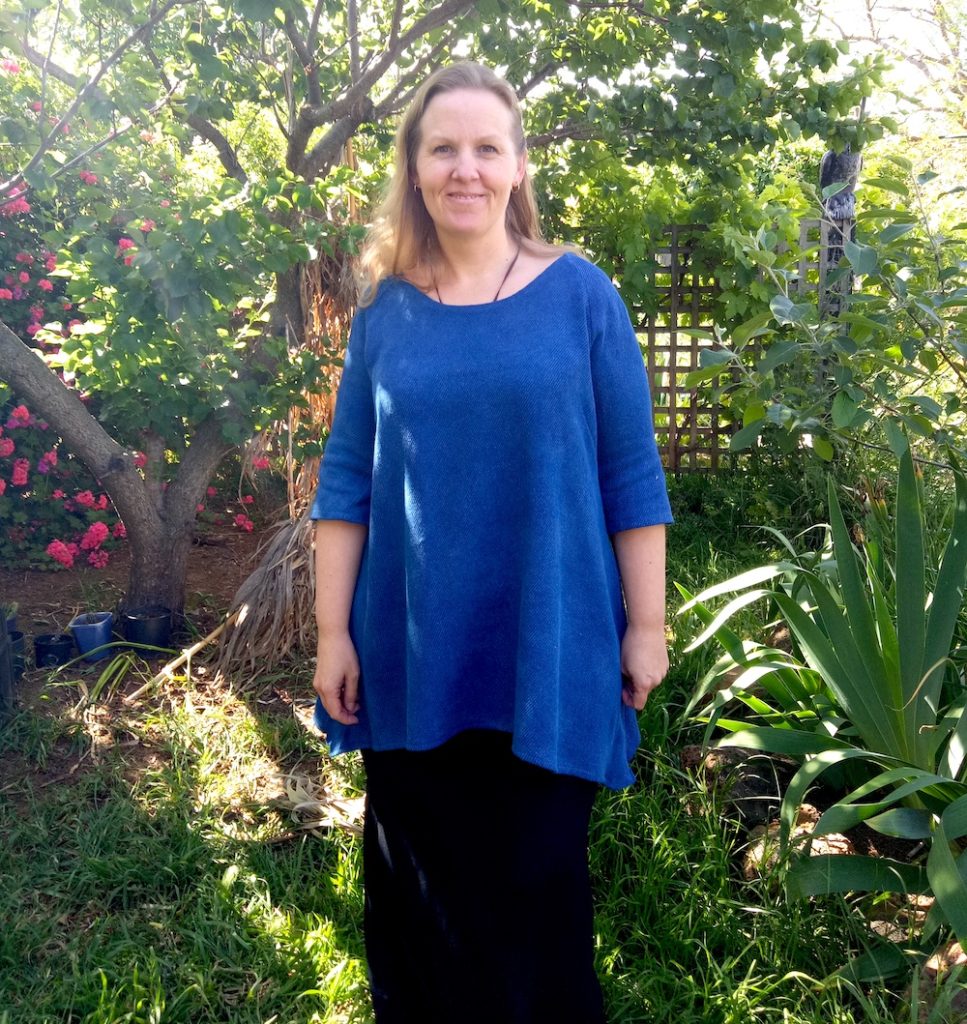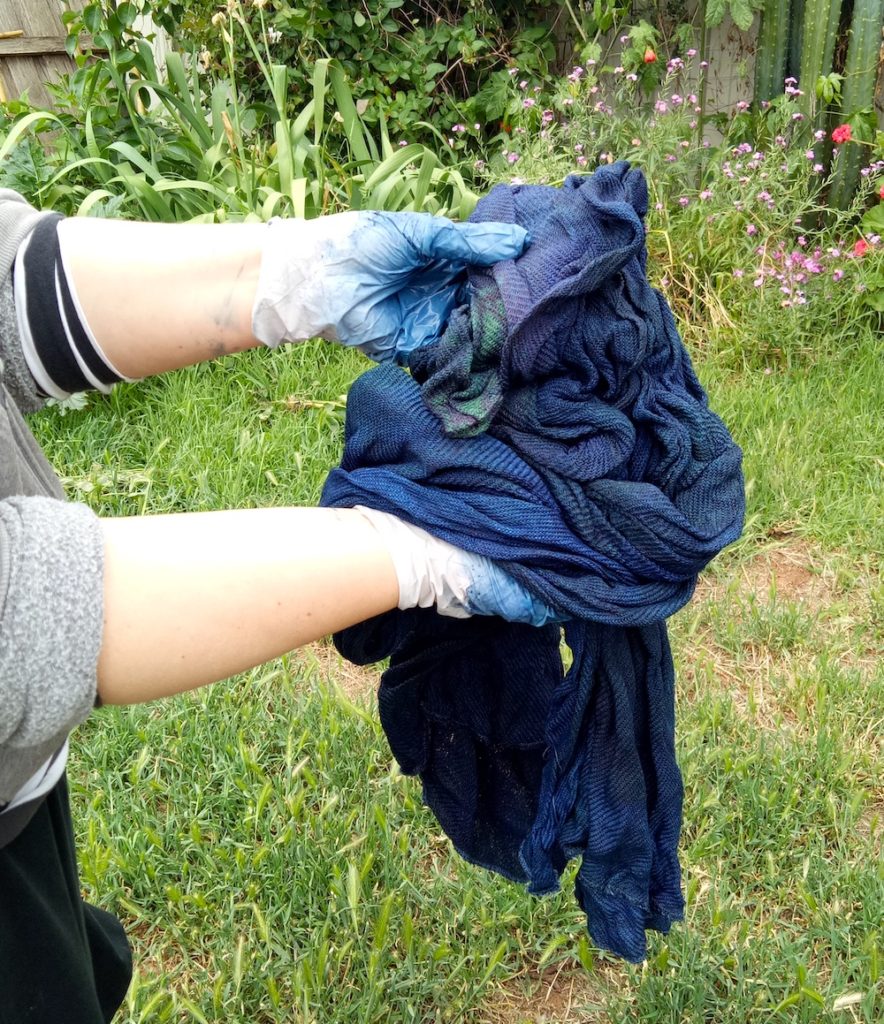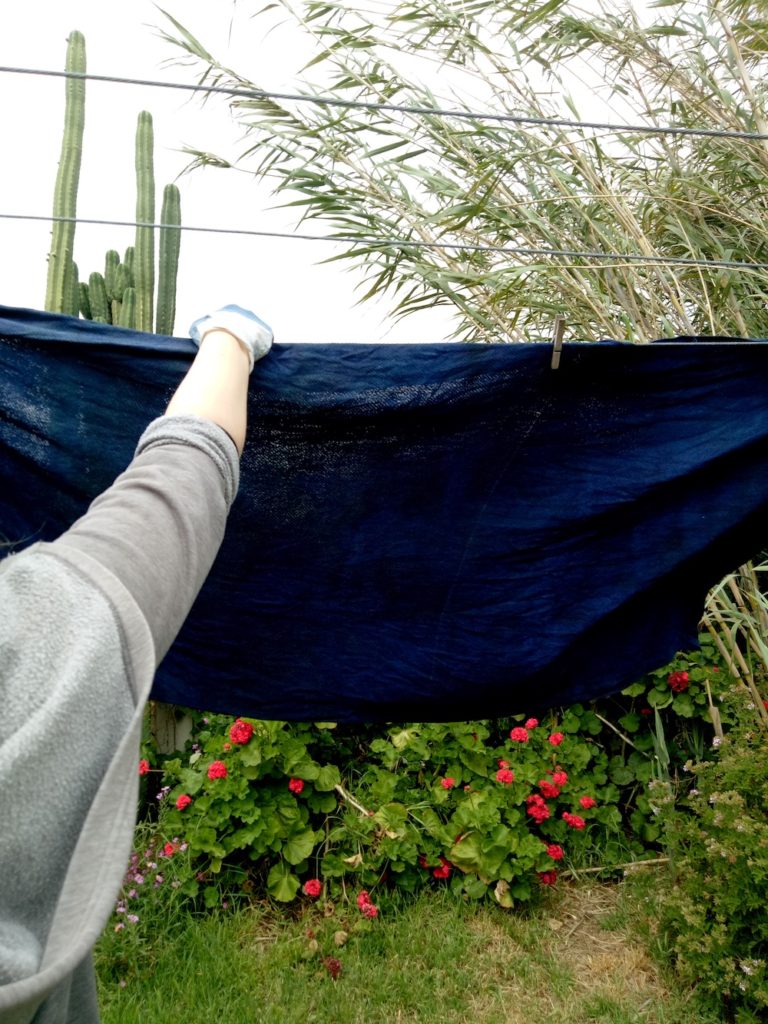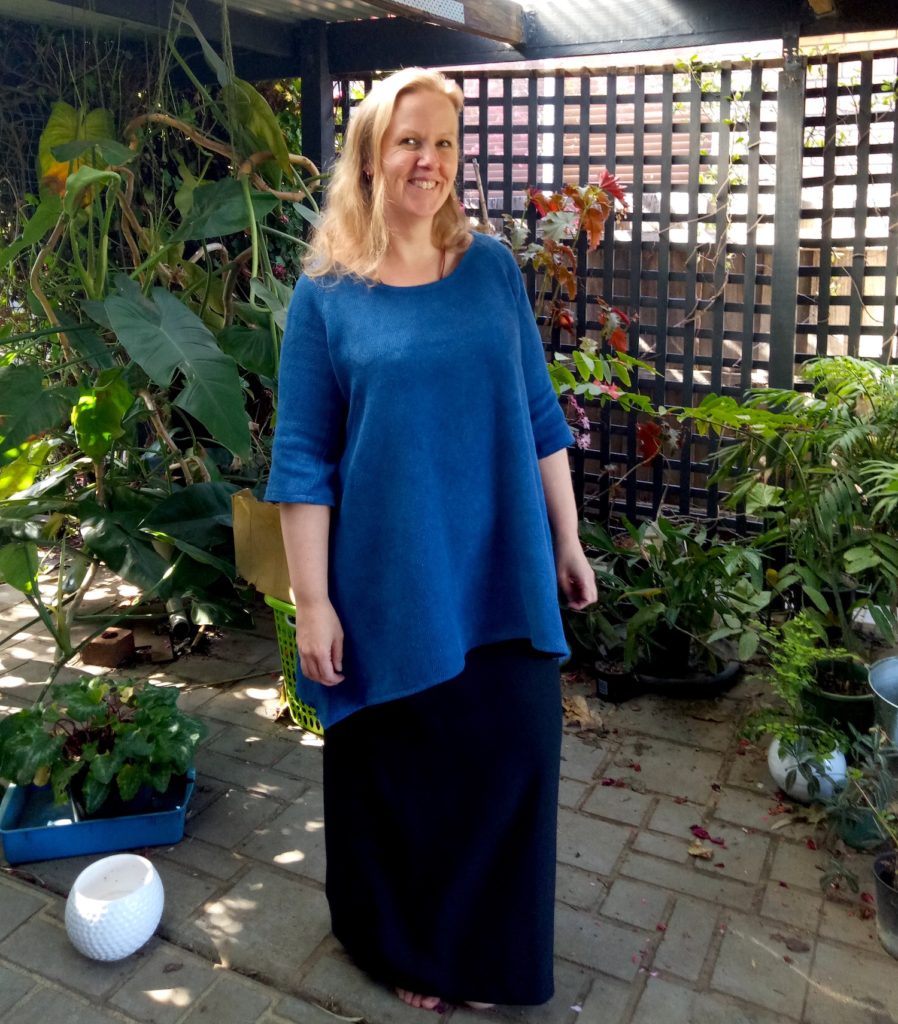I’m so excited to be finished! A little overdue perhaps, but isn’t the nature of slow cloth?
I went through quite a few of the weaving details like yarns and weave structure in last week’s post, so please check that out if you’re interested (and read of my nightmare-ish warp!)
*This post contains an affiliate link
I’m happy to say that the actual weaving was fairly plain sailing and enjoyable with the simple 1&2, 2&3, 3&4, 4&1 order of treadling.
So, once removed from the loom I had a lovely long length of delightful cloth without serious errors (I’m happy to say that the double threading error referred to in the last post does not even show in the finished garment!)
I made a lovely big vat of indigo and tested it with the neck facing pieces I had cut out of a light commercial cotton. The colour was even better than expected, so I felt very good about submitting my long piece of cloth to the vat.
Have you ever dyed with indigo? It is a wonderful, peaceful and relaxing process. While I was standing at my laundry sink, I had the door next to me wide open and a blackbird hopped right up beside me. He didn’t even notice I was there! I thought to myself “perhaps this is the very best way to live. Quietly, slowly, making beautiful things”. It certainly struck me as a beautiful moment in time.
I took my cloth outside (indigo is very messy!) to let the magic happen. As oxygen hits the cloth, it turns from a glorious green to a wonderful blue. The blue is much darker when wet, so I took that into account. I wanted a dark blue. So, I went back to the vat for a total of 3 dippings. On the last dip, I left the cloth sitting in the vat for at least half an hour.
I absolutely love the colour in this shot. I would have preferred that it stay this dark and rich as it dried, but alas that was not the case. I still think it came out a beautiful colour anyway. That is another of the charms of indigo, even if you obtain a very light colour it is bound to be a really beautiful blue – I don’t think an indigo vat can produce anything ugly!
As an aside, I have just begun work on my Journey to Japan course. One of the focuses of the course will be learning to dye with indigo, so if that interests you, be on the lookout for that.
The next step once my fabric was dry was to cut out the pattern. I’m not scared of cutting my handwoven fabric as it all turns out well as long as you take the right precautions. For this project I cut the pieces as I would for commercial fabric but got them quickly to the serger without disturbing the fabric too much, and it was fine. If you’re worried about cutting your handwovens, you may want to check out this video:
There was a hitch with cutting out the pattern though. The fabric had shrunk more than I calculated for. My front and back pattern pieces didn’t fit the folded fabric! Aaaaagh!!
These are the things that feel horrible at the time, but later I am really grateful for. Why? Because I learn! Not only do I learn what to do by thinking about all the possibilities, I also learn that I might be more capable than I thought, which is a great confidence booster! So, I ended up with some odd little shapes and pieces that I tacked on here and there to make up for the lack of width. And it worked!
I now have a comfortable, special garment that fits really well. Unfortunately we are coming into warmer weather here in Australia, so I won’t get much wear out of it this year, but I expect it to last many, many years. If the indigo fades at all, I’ll do as the Japanese do and re-dip it. Only I know the work that went into making this, but that makes it all the more rewarding.
The little voice in me says that the neckline is too wide and so are my hips. But I told the little voice to shut up please, I want to bask in the joy of having woven, dyed and sewn a garment from scratch just for me.
I don’t know if any of you decided to make your own garment for Clothtober, but I’m thinking I need to make this an annual thing, even if it’s just to push myself to do something just for me again.
Until next time…
Happy Weaving!







This is beautiful and it suits you so much. Lovely drapey fabric and great style. And so glad to see realistic advice about cutting and sewing woven fabric. I bought a pattern a while ago which advised ironing wide strips of interfacing wherever you need to cut. I was shocked. I don’t do that with cotton let alone wool!
I love this tunic! I want to make some for myself. I am a knitter, a spinner, and quilter. I have far too many hand knit items right now to fit into my space so I thought I could use my large stash of yarn for making quilts – although still not sure about that. I got a backstrap loom and my brother 3d printed me some heddles in different sizes. I have tried to weave on a rigid heddle before and it was fun, I just don’t have a lot of space and being able to wrap up my work when I am done for the day is a bonus. I don’t know if I could ever make nice clothing out of what I weave. I have so much wool that I really could make 20 quilts. I am glad I found your site and can think of maybe other things to do with my hand-woven stuff. If I can ever get the hang of this backstrap loom.
Hi Reelynn, welcome!
I don’t want to put ideas in your head (😏) but a rigid heddle loom can be hung on the wall if you’re lacking space 😉
I wonder if one can weave this on a RH loom, plain weave and then make it into this lovely wearable.
Yes Nora, for sure you could. I did weave with 10/2 cotton, which would take a while to weave up on a rigid heddle considering the amount of fabric you need. You also need to consider the width of your loom and how that would affect seam placements in the garment. But it’s definitely do-able!
Thanks.
Wow! I am so inspired by you Kelly! Thank you so much for sharing your experiences. The bird landing next to you is magical.
Thanks for reading, I’m glad you enjoyed it!
I love it,, Indigo is so beautiful. I love the blue on the clothesline too, but you are right, Indigo can’t produce anything ugly . The blue is still really pretty, it looks great on you, enjoy. Thank you for posting all your details, I really want to make some parts of my wardrobe with my loom, and sometimes all you see for inspiration is boxy shapeless tops. Which can be a bit depressing, although I know you need to start somewhere.This is well cut, very flattering, not boxy and stiff at all, it flows beautifully.
Thank you very much Marjorie!
Wow! It looks great. Indigo is an amazing way of dyeing. I am just beginning my journey with weaving and it is great to have something to aspire too.
It’s quite addictive!
I love your finished project! And by the way, the neckline and your hips are just right! Great project.
Thank you Debby 🙂
Yup. I came here to say that too.
Thes top looks great and very slimming was it a comercial pattern. Would love to make it
Thank you Maree! It was a free pattern that I changed until it was how I wanted it. The link to the pattern is in this post -http://kellycasanovaweavinglessons.com/category/clothtober
Great, what a wonderful Blue! One question: why didn‘t you dye first, before weaving? Does it make a difference? (Sorry, two questions …)
Greetings from Germany
Siebensachen
That question has a very simple answer – it’s so much easier to dye a piece of cloth than to organise yarn and dye it. Because I was using raw cotton for both weft and warp, I would have had to dye first the warp chains, then wind all of the weft into hanks ready to dye. It would add a lot of extra time (waiting for the yarn to dry too, whereas cloth dries relatively quickly).